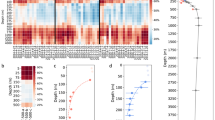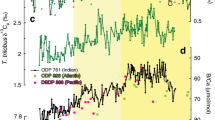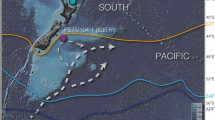Abstract
Continental shelves and slopes comprise less than 20% of the world ocean area, yet they are proposed to be quantitatively important sources of the organic matter that fuels respiration in the open ocean's interior1,2. At least certain regions of the coastal ocean produce more organic carbon than they respire3, suggesting that some fraction of this non-respired, unburied organic carbon is available for export from the coastal to the open ocean4. Previous studies of carbon fluxes in ocean margins1,5,6 have not considered the potential roles of dissolved organic carbon (DOC) and suspended particulate organic carbon (POCsusp), even though both pools are quantitatively far larger than sinking POC. Here we report natural radiocarbon (14C) abundance measurements that reveal continental slope and rise waters to contain both DOC and POCsusp that are concurrently older and in higher concentrations than DOC and POCsusp from the adjacent North Atlantic and North Pacific central gyres. Mass-balance calculations suggest that DOC and POCsusp inputs from ocean margins to the open ocean interior may be more than an order of magnitude greater than inputs of recently produced organic carbon derived from the surface ocean. Inputs from ocean margins may thus be one of the factors contributing to the old apparent age of organic carbon observed in the deep North Atlantic and Pacific central gyres7,8,9.
This is a preview of subscription content, access via your institution
Access options
Subscribe to this journal
Receive 51 print issues and online access
$199.00 per year
only $3.90 per issue
Buy this article
- Purchase on Springer Link
- Instant access to full article PDF
Prices may be subject to local taxes which are calculated during checkout

Similar content being viewed by others
References
Walsh, J., Rowe, G., Iverson, R. & McRoy, C. Biological export of shelf carbon is a sink of the global CO2cycle. Nature 292, 196–201 (1981).
Smith, S. & MacKenzie, F. The ocean as a net heterotrophic system: implications for the carbon biogeochemical cycle. Global Biogeochem. Cycles 1, 187–198 (1987).
Smith, S. & Hollibaugh, T. Coastal metabolism and the oceanic organic carbon balance. Rev. Geophys. 31, 75–89 (1993).
Wollast, R. in Ocean Margin Processes in Global Change (eds Mantoura, R., Martin, J.-M. & Wollast, R.) 365–381 (Wiley, New York, (1991)).
Biscaye, P., Flagg, C. & Falkowski, P. The Shelf Edge Exchange Processes experiment, SEEP-II: an introduction to hypotheses, results and conclusions. Deep-sea Res. II 41, 231–252 (1994).
Walsh, J., Biscaye, P. & Csanady, G. The 1983–1984 Shelf Edge Exchange Processes (SEEP)-I experiment: hypotheses and highlights. Cont. Shelf Res. 8, 435–456 (1988).
Williams, P. & Druffel, E. Radiocarbon in dissolved organic matter in the central North Pacific Ocean. Nature 330, 246–248 (1987).
Bauer, J., Williams, P. & Druffel, E. 14C activity of dissolved organic carbon fractions in the north-central Pacific and Sargasso Sea. Nature 357, 667–670 (1992).
Druffel, E., Williams, P., Bauer, J. & Ertel, J. Cycling of dissolved and particulate matter in the open ocean. J. Geophys. Res. 97, 15,639–15,659 (1992).
Trumbore, S. & Druffel, E. in Role of Nonliving Organic Matter in the Earth's Carbon Cycle (Zepp, R. G. & Sonntag, C.) 7–22 (Wiley and Sons, New York, (1995)).
Druffel, E., Bauer, J., Williams, P., Griffin, S. & Wolgast, D. Seasonal variability of radiocarbon in particulate organic carbon in the northeast Pacific. J. Geophys. Res. 101, 20,543–20,552 (1996).
Bauer, J. E., Druffel, E., Williams, P. M., Wolgast, D. & Griffin, S. Temporal variability in dissolved organic carbon and radiocarbon in the eastern north Pacific Ocean. J. Geophys. Res. (in the press).
Williams, P., Robertson, K., Souter, A., Griffin, S. & Druffel, E. Isotopic signatures (14C, 13C, 15N) as tracers of sources and cycling of soluble and particulate organic matter in the Santa Monica Basin. Prog. Oceanogr. 30, 253–290 (1992).
Smith, K., Kaufman, R. & Baldwin, R. Coupling of near-bottom pelagic and benthic processes at abyssal depths. Limnol. Oceanogr. 39, 1101–1118 (1994).
Stuiver, M., Pearson, G. W. & Braziunas, T. Radiocarbon age calibration of marine samples back to 9000 cal yr B.P. Radiocarbon 28, 980–1021 (1986).
Anderson, R., Rowe, G., Kemp, P., Trumbore, S. & Biscaye, P. Carbon budget for the mid-slope depocenter of the Middle Atlantic Bight. Deep-sea Res. II 41, 669–703 (1994).
Churchill, J., Wirick, C., Flagg, C. & Pietrafesa, L. Sediment resuspension over the continental shelf east of the Delmarva Peninsula. Deep-sea Res. II 41, 341–363 (1994).
Guo, L., Santschi, P., Cifuentes, L. & Trumbore, S. Cycling of high-molecular-weight dissolved organic matter in the Middle Atlantic Bight as revealed by carbon isotopic (13C and 14C) signatures. Limnol. Oceanogr. 41, 1242–1252 (1996).
Tanaka, N., Monaghan, M. & Turekian, K. 14C balance for the Gulf of Maine, Long Island Sound and the northern Middle Atlantic Bight: evidence for the extent of the Antarctic Intermediate Water contribution. J. Mar. Res. 48, 75–87 (1990).
Bauer, J., Spies, R., Vogel, J., Nelson, D. & Southon, J. Natural 14C evidence of fossil carbon cycling in sediments of a marine hydrocarbon seep off California. Nature 348, 230–232 (1990).
Carlson, C. & Ducklow, H. Dissolved organic carbon in the upper ocean of the central Equatorial Pacific, 1992: daily fine-scale vertical variations. Deep-sea Res. II 42, 639–656 (1995).
Cherrier, J., Bauer, J. & Druffel, E. Utilization and turnover of labile dissolved organic matter by bacterial heterotrophs in eastern North Pacific waters. Mar. Ecol. Prog. Ser. 139, 267–279 ((1996)).
Hedges, J. et al. Organic 14C in the Amazon River system. Science 231, 1129–1131 (1986).
Bauer, J., Reimers, C., Druffel, E. & Williams, P. Isotopic constraints on carbon exchanges between deep ocean sediments and seawater. Nature 373, 686–689 (1995).
Jahnke, R., Reimers, C. & Craven, D. Intensification of recycling of organic matter at the sea floor near ocean margins. Nature 348, 50–54 (1990).
Knauss, J. A. Introduction to Physical Oceanography (Prentice-Hall, Englewood Cliffs, NJ, (1978)).
Carlson, C. A., Ducklow, H. W. & Michaels, A. F. Annual flux of dissolved organic carbon from the euphotic zone in the northwestern Sargasso Sea. Nature 371, 405–408 (1994).
Kirchman, D., Suzuki, Y., Garside, C. & Ducklow, H. High turnover rates of dissolved organic carbon during a spring phytoplankton bloom. Nature 352, 612–614 (1991).
Opsahl, S. & Benner, R. Distribution and cycling of terrigenous dissolved organic matter in the ocean. Nature 386, 480–482 (1997).
Vogel, J., Nelson, E. & Southon, J. 14C background levels in an accelerator mass spectrometry system. Radiocarbon 29, 323–333 (1987).
Stuiver, M. & Polach, H. Discussion: reporting of 14C data. Radiocarbon 19, 355–363 (1977).
Acknowledgements
We thank D. Wolgast and S. Griffin for their expert assistance in all phases of this work; K. Smith for shiptime support of our studies in the eastern N. Pacific; M. Kashgarian, J. Southon and I. Proctor of the Center for AMS at Lawrence Livermore National Laboratory for 14C analyses; and J.Hedges and R. Jahnke for reviewing earlier versions of the manuscript. This work was supported by the Ocean Margins Program of the US Department of Energy and the Chemical Oceanography Program of the US NSF.
Author information
Authors and Affiliations
Corresponding author
Rights and permissions
About this article
Cite this article
Bauer, J., Druffel, E. Ocean margins as a significant source of organic matter to the deep open ocean. Nature 392, 482–485 (1998). https://doi.org/10.1038/33122
Received:
Accepted:
Issue Date:
DOI: https://doi.org/10.1038/33122
This article is cited by
-
Variability of Particulate Amino Acids and Processes Responsible for Sources into the Coastal Waters of the Bay of Bengal
Estuaries and Coasts (2024)
-
Assessment of prokaryotic communities in Southwestern Atlantic deep-sea sediments reveals prevalent methanol-oxidising Methylomirabilales
Scientific Reports (2023)
-
Single-cell view of deep-sea microbial activity and intracommunity heterogeneity
The ISME Journal (2023)
-
Bacterial consumption of total and dissolved organic carbon in the Great Barrier Reef
Biogeochemistry (2021)
-
Influence of phytoplankton pigment composition and primary production on pCO2 levels in the Indian Ocean
Journal of Earth System Science (2021)
Comments
By submitting a comment you agree to abide by our Terms and Community Guidelines. If you find something abusive or that does not comply with our terms or guidelines please flag it as inappropriate.



